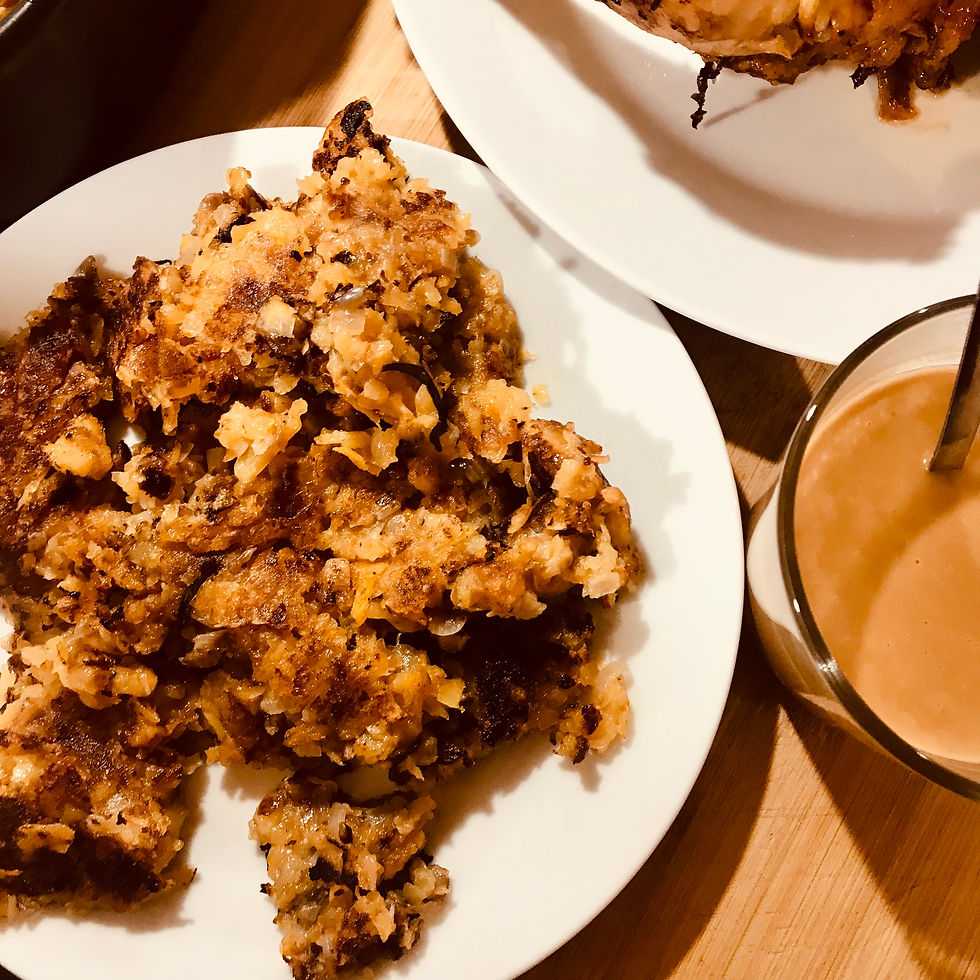Roast chicken stuffed with haggis—vegetarian haggis in this case—and prunes is hardly a traditional dish. But, it's what I whimsically chose to cook on my recent birthday luckily back in Edinburgh once again. And, I'm very glad I did.

A tale of two houses
For my birthday back in Edinburgh this year, I got it into my head that I was going to roast a chicken stuffed with haggis and prunes, served with a suitably comical accompaniment with a partial nod to Scottish cuisine. Well, said chicken was actually stuffed with vegetarian haggis (yes, it's a thing!) and prunes. Long ago—remember, this was a birthday marking that I'm no longer young—I used to roast game birds (pheasant, grouse, guinea fowl etc.) with traditional, proper meat haggis. Of course, that works fabulously if you're feeling more "gamey". But my gut instinct told me that McSween's famous vegetarian haggis would be far better suited to the mild flesh of a chicken.
I'm not getting into the minutiae, but I wanted to make a meal that was about the Celtic part of me reconciling with the Germanic part of me. So, this was the outcome menu: roast chicken stuffed with vegetarian haggis and prunes with whisky cream sauce; braised Savoy cabbage and tatties 'n neeps rösti. No, most definitely not haute cuisine. Rather, homely, down home and seasonal.
"Tatties and neeps" are a traditional Scottish accompaniment with many dishes. There is something rather amusing about it. While everyone generally agrees that "tatties" refers to the potatoes in the dish, Scots argue endlessly whether the "neeps" refers to turnips or swede. In reality, both root vegetables are commonly used in this dish and, according to some linguists, the Scots word "neeps" can refer to numerous root vegetables including turnips, swede or kohlrabi. While I generally default to using swede, they're all good. Choose the one that you like the most.
In this recipe, the tatties 'n neeps are not cooked in the traditional Scottish method, but instead done as a nod to the Swiss dish of rösti.
Similarly, I opted to serve it with braised Savoy cabbage a dish that is very much from Germany and Mitteleuropa rather than Scotland.
Here this dish was cooked for two diners. Obviously, it could have easily been expanded to feed twice the number. The leftover chicken created delicious lunches the next day, but the vegetable quantities given here are what you will need for 2 to 3 diners.
Shopping list
for the roast chicken stuffed with haggis and prunes
1 small organic chicken (e.g. 1.5kg)
⅓ of a vegetarian haggis (or 3 or 4 veggie haggis slices)
7 or 8 prunes; tinned or dried and rehydrated in boiling water
a generous clutch of fresh tarragon
1 small bag (e.g. 25g) "roast chicken flavour" crisps (potato chips)
Approx. 6 tbspns olive oil
salt and pepper to taste
for the tattie 'n neep rösti
½ a swede, peeled and grated
Approx. 8 small potatoes (or equivalent), peeled and grated
4 tbspns unsalted butter
4 echalion shallots, diced
2 tspns of oregano
salt and pepper to taste
for the braised Savoy cabbage with apple
½ a Savoy cabbage, thinly sliced
6 tbspns of olive oil (or goose fat)
1 large sour apple (e.g. Bramley or Granny Smith), peeled and grated
1 cup white wine vinegar
300ml white wine
2 large cloves of garlic, roughly sliced
salt and pepper to taste
for the whisky cream sauce
⅓ cup (85 ml) whisky
the roasting juices from the chicken
½ cup (125 ml) cream
2 to 3 tspn coarsely crushed green peppercorns
Cooking Method
for the roast chicken stuffed with haggis and prunes
Rub down the chicken with a basic seasoning of a little salt and pepper while you heat the olive oil on a hight heat in the oven at 250°C in a roasting pan. At the same time, place a second baking tray towards the bottom of the oven with approx. 2cm of boiling water poured into it. This will ensure the bird remains moist
Stuff the vegetarian haggis, fresh tarragon and prunes into the bird's cavity. When the oil is piping hot, remove the roasting dish from the oven and place the bird into the hot oil, turning to ensure that it's fully coated. Reduce the heat to 200°C. Return the chicken to the oven, initially cooking "upside down" so that the base cooks first, adding extra sprigs of the fresh tarragon laid onto the skin
A reasonably small chicken will take approx. 1.5 to 2 hours to cook. During this time, you'll need to turn it about every 20mins to ensure it roasts evenly. If necessary, add additional boiling water to the pan below where the bird is roasting
After the chicken has been roasting for approx 1.2 hours, crush the bag of crisps. Remove the chicken from the oven and press these broken small "chips" onto the skin of the bird. Return to the oven and continue to roast. When cooked for approx. 15mins on one side, repeat the process, pressing the remainder of the crisps onto the other side of the chicken and return to the oven until they too are roasted
When the chicken is optimally roasted, turn the oven off and allow to rest for approx. 10mins. Carve the bird, loosen the stuffing and take to table with the accompanying dishes
for the tattie 'n neep rösti
Bring a pot of salted water to a vigorous boil. Add the grated potatoes and swede and parboil for no more than 5mins—you can even do this the day before—drain thoroughly, pressing out all of the water (and the released starch)
In a large frying pan, melt the butter on a medium heat. When it begins to bubble, add the diced echalion shallots and sauté
When the shallots soften, add the parboiled and drained swede and potatoes. Stir together, ensuring the melted butter is distributed evenly (add a little more if necessary) and coats all the ingredients
Add the oregano, salt and pepper and sauté for approx. 20 mins, allowing the potatoes and swede to brown/crisp and then re-stir so that the crispy edges are spread throughout the dish, contrasting with the softer elements
Once cooked, remove from the heat. This dish will easily reheat in the oven if you cook it earlier than serving up the meal. Otherwise, take to table with the chicken and cabbage

for the braised Savoy cabbage with apple
While preparing the chicken for roasting, add the olive oil and sliced garlic to a fairly deep roasting pan or ovenproof dish and heat for at least 15mins in the oven at 250°C
When the garlic has sizzled for a while, remove the dish from the oven and add the sliced Savoy cabbage, turning it over so that it's coated in the oil. Add the grated apple to the top of the dish and season with salt and pepper. Pour in the vinegar and half of the white wine. Return to the oven and cook at 250°C for the first 20mins or so, ensuring to remove from the oven and stir to prevent burning every 5mins or so. Each time you turn the cabbage and apple, ensure that the liquid fully coats the ingredients to reduce the risk of burning
Cook the dish for approx. 1 to 1.5 hours (taking into account that you will reduce the oven temperature to 250°C when roasting the chicken). As the cabbage cooks and softens, you won't need to turn it as regularly. Add the remaining wine incrementally every 20mins or so. When the cabbage is optimally cooked, remove from the oven and allow to rest (it's likely to be cooked before the chicken)
Return to the oven to reheat approx. 10 to 15mins before taking to table with the rest of the meal

for the whisky cream sauce
When the chicken is cooked, drain the roasting juices into a small saucepan, adding the crushed green peppercorns and whisky. Heat on a medium-to-high heat, whisking gently
Add in the cream and blend into the sauce, whisking more vigorously. Once it's blended, remove from the heat. If you're feeling fancy, pass through a sieve. Otherwise decant to a sauce dish and take to table with the rest of the meal
Alternatives
Even I can't pretend to cook a vegetarian or vegan version of a roast chicken. Sorry! However the veggie/vegan dishes served here as accompaniments work well with other vegan/veggie dishes such as nut roasts.
Pairings
On this occasion we had this main course with a Château La Clarière Blanc 2021, which proved a very good move. But, I suspect it would work well with any dry white ballsy enough to balance the more intense flavours of the tarragon and whisky. Part of me felt guilty that I hadn't gone with one of my beloved South African chenin blancs, those peppery—there's a lot of pepper in this meal—and most macho of white wines that are a bit like the dichotomy of rugby-player-by-day-drag-queen-by-night Cape viniculture.























Comments